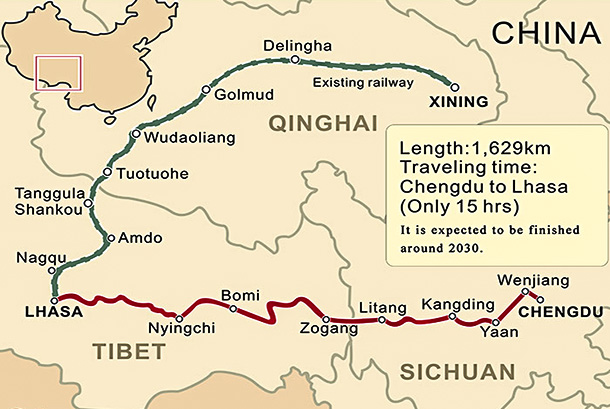 Dharamshala — China's state-run media recently claimed that, China is going to build a second railway running through Tibet, so called the Sichuan-Tibet railway.
Dharamshala — China's state-run media recently claimed that, China is going to build a second railway running through Tibet, so called the Sichuan-Tibet railway.
This will be China's second railway line to Tibet, linking Lhasa, U-Tsang Province of Tibet with Dartsedo, Kham Province of eastern Tibet, then the city of Chengdu, Sichuan, China.
In 2006, China opened "Qinghai-Tibet Railway" railway as part of the so called Chinese government development efforts. It passes through the spectacular Tibetan highlands, at altitudes as high as 5,000 metres (16,400ft) above sea level.
The Xinhua News Agency reveals that the "Sichuan-Tibet Railway" has been listed in the draft outline of the 13th Five-Year Plan (2016-2020) released on March 5, 2016.
Based on interviews with Chengdu's Development and Reformation Committee , another Chinese state-run media "People's Web" also reported that the Sichuan-Tibet railway would be one of the five new railways connecting Chengdu with other capital cities of neighbour provinces. This construction aims at facilitating Chengdu to become the inland transportation nexus.
Xinhua confirmed again on March 16 that the Sichuan-Tibet railway has been listed as one of the most important projects for the 13th Five-Year Plan, which means hat the Sichuan-Tibet railway has been put onto agenda.
According to limited details from multiple Chinese state media sources, the known stations along the new railway line are, Dartsedo City (Ch: Kangding),Yaknga City(Ch:Ya'an), Chamdo City (Ch: Changdu), and Nyingchi City (Ch: Linzhi), making four sections separately: the Chengdu to Yaknga, Yaknga to Darzedo, Dartsedo to Nyingchi, and Nyingchi to Lhasa.
The estimated hours from Chengdu to Lhasa will be reduced to 15 hours, comparing to the previous 42 hours along the Qinghai-Tibet railway. However, these media sources have different number regarding the estimated total distance of the railway. According to China Daily and Xinhua, the whole Chengdu-Tibet railway will be about 1,629 kilometers, while for People's Web, the operating length is around 1,900 kilometers and the construction length is around 1,800 kilometers.
Among these sections, the construction of Chengdu to Yaknga section has already been on, and will be finished in 2018. And the National Development and Reformation Committee have already approved the Chengdu to Dartsedo section earlier on. For the Lyingchi to Lhasa section, it was started in Dec. 2014.
Many interviews featured the difficulty as well as high cost of the construction of the Chengdu-Tibet railway. According to China's Daily,Lin Shijin, a senior civil engineer at China Railway Corporation, said, 'The accumulated height it will climb reaches more than 14,000 meters, and it will cross many fault zones...It's like the largest roller-coaster in the world. With a designed service life of 100 years, it is believed to be one of the most difficult railway projects to build on Earth."
No word about the impact on environment as well as the potential destruction of the vulnerable natural environment at the high plateau was mentioned. And no plan regarding how to deal with the road construction in Tibetan region where culture and religion is drastically different from China was reflected.
China's first railway to Tibet, the Qinghai-Tibet railway opened in 2006, has caused fierce discussions and critiques in terms of environmental deteriorations in this vulnerable plateau, with the average elevation exceeding 4,555 metres (14,800 ft).The Tibetan plateau is also home to 125 rare species animals like Tibetan Antelope, black bear, clouded leopard, black muntjac, musk deer, giant panda, wild yak, golden monkey, etc.and 40 kinds of rare species plants. There is no official evaluation as to how this Chengdu-Tibet railway may affect wildlife in Tibet so far.
English-language mainstream media have paid attention to this Chinese government initiated huge construction project in Tibet. The Guardian's news on Mar. 5 about the plan of Chengdu-Tibet railway noticed that, even though many Tibetans are opposing Chinese control, the region holds a strategic position next to India, Nepal, and Myanmar.
The Economist article on May 21 featuring this new railway is concerned with the escalating Chinese migration and tourism would cause negative impact on Tibet and Tibetans.
The Diplomat on May 27 also focuses on this new railway and its connection with China's 'One Belt, One Road' policy. The article commented that the implications of this railway centre on China's 'expedited control' over Tibet.
Sarcastically, these intense report on the Chengdu-Tibet railway project by the Chinese state media were posted in March, the most memorial as well as 'miserable' month for Tibetans. This special month includes the Tibetan national uprising day on Mar. 10 since Dalai Lama's flight to India in 1959. The 2008 Tibetan unrest also started and got repressed in March.
Critics of the railway, including Tibetans and rights groups, say it has spurred an influx of long-term migrants who threaten Tibetans' cultural integrity, which rests on Buddhist beliefs and a traditional herding lifestyle. But the regime in Beijing consistently denies any rights abuses or cultural disrespect in Tibet, claiming the Chinese government's rule has bought much-needed economy development.
The preservation of traditional Tibetan place names is particularly politically charged, according to recent reports. The Chinese-designated "autonomous", "prefectures" and "counties" are traditional territories of Tibet, or Cholka-Sum. Large areas of Qinghai and Sichuan provinces, as well as parts of Gansu and yunnan, are traditionally parts of North-Eastern and Eastern Tibet, or the traditional regions of Kham and Amdo, while the Chinese-designated TAR is historically U-Tsang. All are lying within Cholka-Sum, also rendered as "Historic Tibet."


![Tibet has a rich history as a sovereign nation until the 1950s when it was invaded by China. [Photo: File]](/images/stories/Pics-2024/March/Tibet-Nation-1940s.jpg#joomlaImage://local-images/stories/Pics-2024/March/Tibet-Nation-1940s.jpg?width=1489&height=878)

















